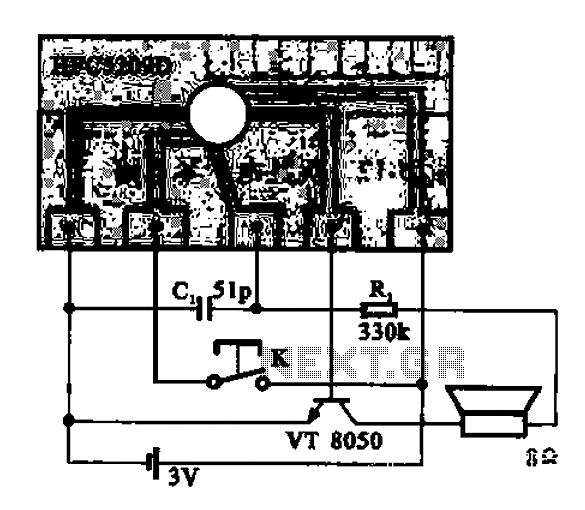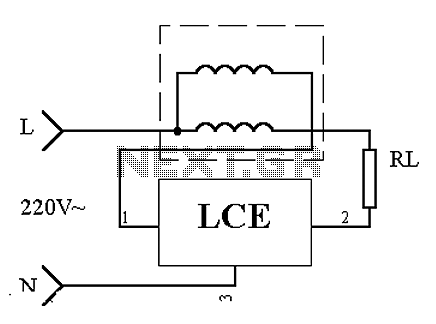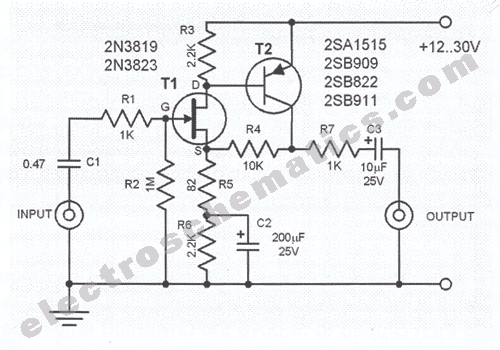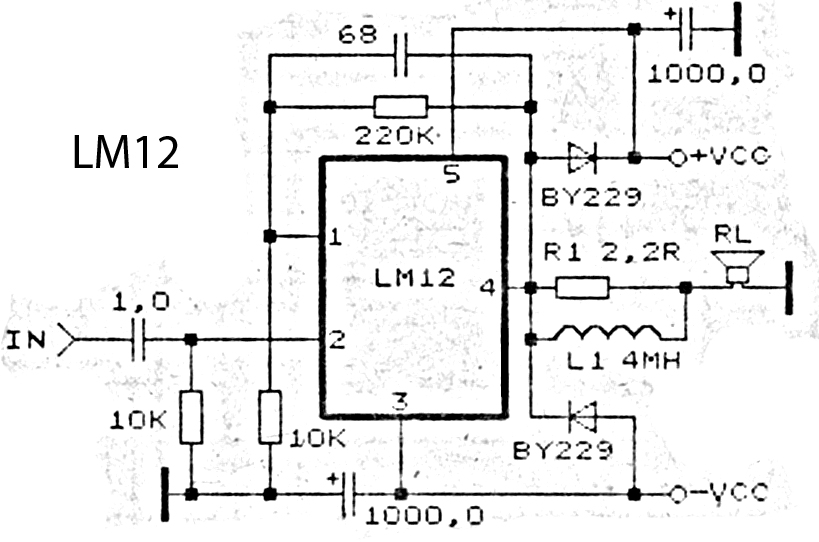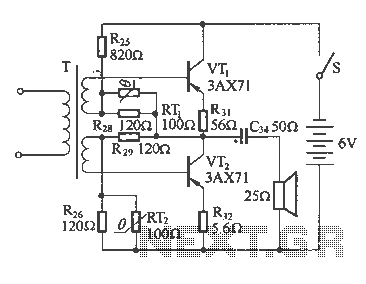
TDA1514 40 Watt Audio Amplifier Circuit
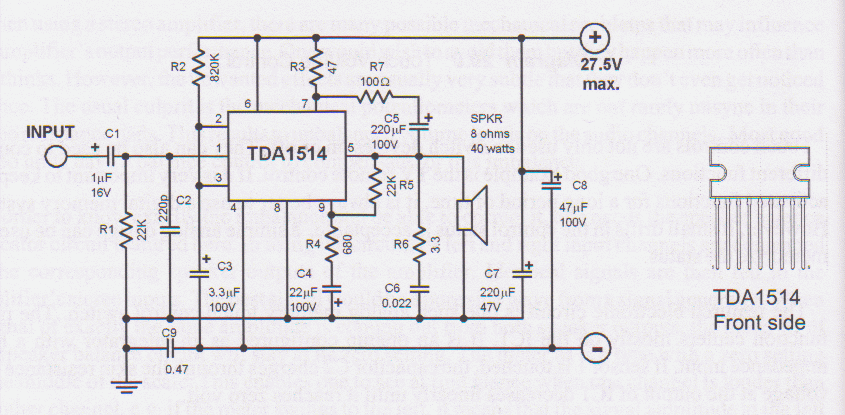
This is a compact, easy-to-build amplifier that utilizes a single integrated circuit (IC) to deliver 40 watts of audio power. It is well-suited for amplifying audio signals from devices such as mobile CD players or iPods. The integrated circuit employed in this design is the TDA1514, which was originally introduced by Philips/Valvo. The notable features of this chip include its high output power and durability. It is packaged in a 9-pin SIL plastic package with a metal mount, exhibiting a heat resistance of less than 1.5 K/W. Consequently, the heatsink must have a heat resistance of no more than 3.8 K/W when the chip reaches its maximum power dissipation of 19W (with a supply voltage of ±27.5V and an ambient temperature of 50°C). The schematic indicates that only a few passive components are necessary to construct a powerful audio amplifier using this chip. The power supply must be capable of providing a current of at least 3 amperes, and the standby current consumption is approximately 60 mA. Furthermore, the supply voltage must not exceed 27.5 volts. During construction, it is advisable to keep the wires connecting to the power supply and outputs as short as possible. Resistors R4 and R5 determine the voltage gain at the feedback, which ranges from 20 to 46 dB. For a mono amplifier, an 80 VA transformer (T1) is adequate, while a 120 VA transformer is recommended for stereo configurations. Capacitors Cx and Cy should have a minimum capacitance of 4,700 µF rated at 35V, with the option to increase to 10,000 µF. Larger capacitors discharge more slowly, providing better peak power potential and enhancing power output. However, it is important to note that increasing capacitance may not yield significant benefits relative to cost. Proper orientation of the capacitors is critical to prevent failure and potential injury. A 0.25 mA fuse (F1) should be included in the design, and if using a toroidal transformer, a time delay (slow blow) fuse is required. Proper grounding of the supply and any metal casing is essential. The components connected to the earth and ground (Dx, Dy, Rx, Cz) form a loop breaker, which helps eliminate troublesome earth loops. Rx should be a wirewound resistor rated at 5 W or higher, while capacitor Cz must be rated for 250 V AC; a 250 V DC capacitor is unsuitable for this application due to the risk of failure in fault conditions. Diodes Dx and Dy are rated at 250 V and 1 A. If local regulations prohibit construction of this circuit, all components should be omitted, and the earth should be connected to ground, but the earth lead must never be disconnected, as it is crucial for safety. Constructing the power supply for this amplifier is straightforward. As illustrated in the schematic, a center-tapped 18-0-18 transformer is required to achieve the recommended ±25V. Extreme caution is advised during this construction due to the involvement of mains wiring.
The described amplifier circuit is designed to provide a robust audio amplification solution suitable for various applications. The TDA1514 IC is favored for its reliability and performance, making it a preferred choice for audio enthusiasts. The circuit's simplicity allows for easy assembly, requiring only a minimal number of additional components, which contributes to its compact form factor.
The selection of a suitable transformer is crucial, as it directly affects the amplifier's performance. The transformer must be rated appropriately to handle the current requirements while providing sufficient voltage to the amplifier circuit. The use of large capacitors in the power supply helps to stabilize the voltage and improve transient response, essential for high-fidelity audio reproduction.
In terms of safety, the inclusion of fuses and proper grounding techniques is vital to prevent hazards associated with electrical faults. The loop breaker configuration is particularly effective in minimizing noise and interference, which can degrade audio quality.
Overall, this amplifier circuit exemplifies a balance between performance, simplicity, and safety, making it an excellent choice for those looking to build their own audio amplification system.This is a compact, easy to build amplifier that uses one IC only but delivers 40 watts of audio power. It is ideal for amplifying audio from your mobile CD player or iPod. The chip being used here is the TDA1514 originally brought to the market by Phillips/Valvo. The best characteristics of this chip is its high output power and robustness. It is available in a 9-pin SIL plastic package with a metal mount. Its package has a heat resistance of less than 1. 5K/W. This means that the heatsink must have a heat resistance of only 3. 8K/W when the chip reaches its maximum power dissipation of 19W (at Ub = +/-27. 5V, Tu = 500C). One can see from the diagram that only a handful of passive elements are needed to build the chip into a powerful audio amplifier. The power supply as supplied must be able to deliver a current of at least 3 amperes. The standby current consumption is about 60 mA. The supply voltage must never go beyond 27. 5 volts! In building the circuit, keep the wires to the power supply and outputs as short as possible. The resistos R4 and R5 set the voltage gain at the feedback which, in this case, is between 20 and 46 dB.
For a single channel amplifier(mono), a 80 VA transformer (T1) should be sufficient. If you construct two channels (or stereo) amps, 120 VA is recommended. Capacitors Cx and Cy should be at least 4. 700uF rated at 35V. It can be up to 10. 000uF. Capacitors twice as large discharge slower giving better peak power potential resulting to better power output. Feel free to increase the capacitance but take note that you may not get much additional benefit for the price involved.
Make sure they are connected the right way around too or they will blow and cause injury. A 0. 25 mA fuse (F1) should be installed. If using toroidal transformer, the fuse must be a time delay (slow blow) variant. Be sure to correctly earth the supply and any metal casing around it. The components on the earth and ground connections (Dx, Dy, Rx, Cz) form a loop breaker. This is recommended because it can eliminate those troublesome earth loops. Rx is a 5 W or better wirewound resistor. The Cz capacitor must be rated for 250 V AC. Do NOT use a 250 V DC capacitor for Cz as it would fail if there ever was a fault causing mains current to flow to earth. Dx and Dy are rated at 250 V/ 1 A. If your local rules and regulations prohibit constructing this, omit all these components and connect the earth to ground but NEVER disconnect the earth lead it could save your life or somebody elses!
Constructing the power supply for this amplifier is simple. As shown on the schematic above you need to wire up a 18-0-18 (center tapped) transformer in order to get the recommended +/- 25V. Be very careful since this construction involves mains wiring. 🔗 External reference
The described amplifier circuit is designed to provide a robust audio amplification solution suitable for various applications. The TDA1514 IC is favored for its reliability and performance, making it a preferred choice for audio enthusiasts. The circuit's simplicity allows for easy assembly, requiring only a minimal number of additional components, which contributes to its compact form factor.
The selection of a suitable transformer is crucial, as it directly affects the amplifier's performance. The transformer must be rated appropriately to handle the current requirements while providing sufficient voltage to the amplifier circuit. The use of large capacitors in the power supply helps to stabilize the voltage and improve transient response, essential for high-fidelity audio reproduction.
In terms of safety, the inclusion of fuses and proper grounding techniques is vital to prevent hazards associated with electrical faults. The loop breaker configuration is particularly effective in minimizing noise and interference, which can degrade audio quality.
Overall, this amplifier circuit exemplifies a balance between performance, simplicity, and safety, making it an excellent choice for those looking to build their own audio amplification system.This is a compact, easy to build amplifier that uses one IC only but delivers 40 watts of audio power. It is ideal for amplifying audio from your mobile CD player or iPod. The chip being used here is the TDA1514 originally brought to the market by Phillips/Valvo. The best characteristics of this chip is its high output power and robustness. It is available in a 9-pin SIL plastic package with a metal mount. Its package has a heat resistance of less than 1. 5K/W. This means that the heatsink must have a heat resistance of only 3. 8K/W when the chip reaches its maximum power dissipation of 19W (at Ub = +/-27. 5V, Tu = 500C). One can see from the diagram that only a handful of passive elements are needed to build the chip into a powerful audio amplifier. The power supply as supplied must be able to deliver a current of at least 3 amperes. The standby current consumption is about 60 mA. The supply voltage must never go beyond 27. 5 volts! In building the circuit, keep the wires to the power supply and outputs as short as possible. The resistos R4 and R5 set the voltage gain at the feedback which, in this case, is between 20 and 46 dB.
For a single channel amplifier(mono), a 80 VA transformer (T1) should be sufficient. If you construct two channels (or stereo) amps, 120 VA is recommended. Capacitors Cx and Cy should be at least 4. 700uF rated at 35V. It can be up to 10. 000uF. Capacitors twice as large discharge slower giving better peak power potential resulting to better power output. Feel free to increase the capacitance but take note that you may not get much additional benefit for the price involved.
Make sure they are connected the right way around too or they will blow and cause injury. A 0. 25 mA fuse (F1) should be installed. If using toroidal transformer, the fuse must be a time delay (slow blow) variant. Be sure to correctly earth the supply and any metal casing around it. The components on the earth and ground connections (Dx, Dy, Rx, Cz) form a loop breaker. This is recommended because it can eliminate those troublesome earth loops. Rx is a 5 W or better wirewound resistor. The Cz capacitor must be rated for 250 V AC. Do NOT use a 250 V DC capacitor for Cz as it would fail if there ever was a fault causing mains current to flow to earth. Dx and Dy are rated at 250 V/ 1 A. If your local rules and regulations prohibit constructing this, omit all these components and connect the earth to ground but NEVER disconnect the earth lead it could save your life or somebody elses!
Constructing the power supply for this amplifier is simple. As shown on the schematic above you need to wire up a 18-0-18 (center tapped) transformer in order to get the recommended +/- 25V. Be very careful since this construction involves mains wiring. 🔗 External reference
